Honey is a natural, tasty and healthy delicacy, which can be used as a separate product, as well as by adding to dishes as desired. However, along with the benefits, honey is fraught with danger. Firstly, honey is a strong allergen. Children under one year are not recommended. Secondly, it is also better for diabetics to refrain from consuming this delicacy.
In this article we will look at honey in different aspects. We recognize its caloric content, let’s see if it can be used by diabetics and from what age can be given to children.
Table of contents
- Calorie honey: how many calories are in one teaspoon?
- What contains more calories: sugar or honey?
- Can I use with diabetes: the benefits and harm
- Sugary
- How many kilograms / gram fit in a liter / three-liter jar?
- How much can a bee product eat per day for an adult and an infant?
- Chemical composition and table of contents of components
- GOST for honey products
- How, where and in what to store the real natural product?
Calorie honey: how many calories are in one teaspoon?
Taste is always accompanied by nutrition, therefore honey is a high-calorie product found on our tables. But this is no reason to abandon it during a diet. It is necessary with rationality, not overeating, to use it.
| Type of honey | kcal per 100 grams |
| Floral | 303 |
| Acacia | 335 |
| Buckwheat | 301 |
| Heathy | 309 |
| Honeycomb | 327 |
| Lime | 323 |
| Honey with nuts | 485 |
As can be seen from the table, each type of beekeeping product has its own caloric content. But 100 grams is not a very clear concept. Where it is clearer to consider honey spoons. So how many calories in 1 teaspoon and tablespoon of honey:
- In 1 teaspoon with a hill - 32 Kcal
- In 1 tablespoon with a slide - 72 Kcal
Linden honey - a product consisting of a maximum of useful substances,what makes it the most delicious and popular, in comparison with other varieties. 100 grams of delicacy contains about 320 Kcal.
Bees collect honey buckwheat from flowering buckwheat nectar. His hue is bright, from yellow to brown, and sometimes reddish. This product is classified as high quality, with a pleasant aroma. It contains 37% glucose and 40% fructose, which contributes to its high caloric content - per 100 g 301 kcal.
People have long wondered: is there any sugar in the composition of honey? Yes, but not the same as in the store, but fruit and grape, in the form of fructose with glucose, while being well digestible by the body.
In the complex composition of natural honey, the main place is occupied by carbohydrates.whose number is about 86%. Depending on the variety, carbohydrates can over 40 types.
The main ones are glucose and fructose. Their number is up to 90% by weight of all carbohydrates. The rest are complex oligosaccharides, disaccharides and sucrose. Its composition of the product of beekeeping is about 3%.
What contains more calories: sugar or honey?
Many people wonder if honey is calorie. Let's disassemble. Sugar contains more calories than honey.For example, in a teaspoon of sugar - up to 18 calories, and in honey - 27 calories.
In this case, the caloric content of the honey delicacy is higher, but not due to the fact that sugar is lower in calories, but because honey has a higher density and in a spoon it is placed a little more than sugar. In 100 grams of sugar - 400 Kcal, in honey about 330 Kcal.
Despite its usefulness, the honey product is rather caloric, while sugar is less useful and has a higher caloric content. At the same time, the honey calories are absorbed much faster, and the consumption of sugar contributes to rapid fatigue, the appearance of caries and drowsiness.
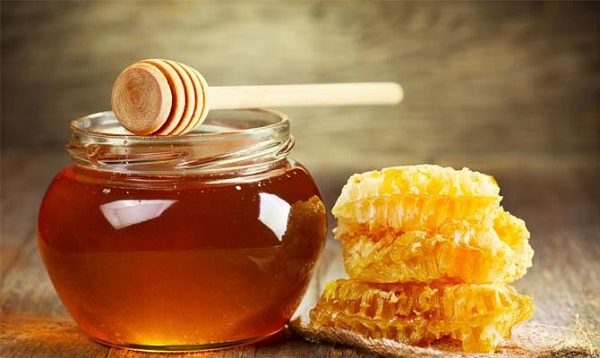
Can I use with diabetes: the benefits and harm
Is it possible to eat honey with diabetes? In this question there are many different opinions. Some believe that honey for diabetics is beneficial - lowers blood sugar, and the rest claim that honey product enhances it.
Studies show that the use of honey in diabetes is not always permissible.
With diabetes requires strict adherence to the diet, and in its non-compliance there is no difference than to poison yourself - with sugar or honey in large doses. But with elevated blood sugar levels - honey is contraindicated.
Experts say that the use of honey delicacy in type 1 diabetes is not only possible but necessary. By repeated experiments it has been proved that the constant consumption of this delicacy contributes to reducing the pressure and normalizing the level of glycohemoglobin by 2%.
Due to its composition, honey is very slowly absorbed, which contributes to the stabilization of glucose in the blood. Therefore, the question: is it possible to eat honey in case of diabetes mellitus type 2 will also be positive. The main thing is to observe strict daily dosage - 1 tbsp. in a day. With large quantities, serious problems can begin.
Sugary
And now let's look at whether honey should be sugared and why this happens.Honey crystallization is a natural process, if only it is natural and without any additives. Its character is influenced by certain factors that reveal the speed and characteristics of this process. At a temperature of 35 ° C, the honey begins to melt gradually.
When 40-50 ° C is exceeded, most nutrients are destroyed, and the bee product becomes an ordinary sweet syrup. Therefore, if honey is sugared - this is considered the norm.
Glucose and fructose are the main components of honey. Thanks to these elements, honey is candied. Glucose hardens, and fructose does not change the liquid state, enveloping glucose. When scooping crystallized honey from a can, you can see a small amount of liquid honey.
What homemade honey is not sugared and why?
The coefficient of fructose and glucose is the main indicator that gives an estimate of the strength of honey sugared. Delicacy with a high amount of fructose is sugared slowly and softens easily.
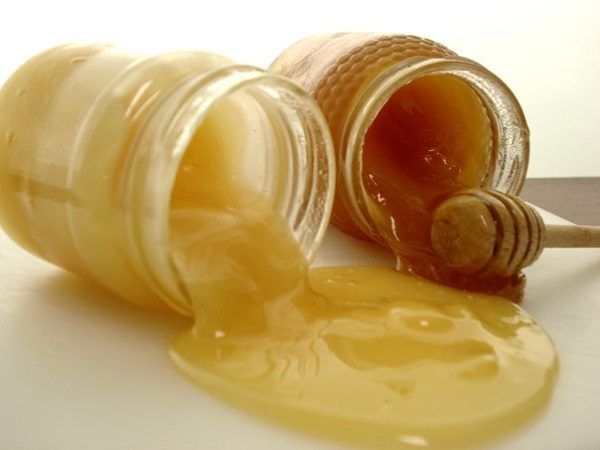
Glucose crystals collect at the bottom, and a dark mass rises to the top. A vivid example of this, honey from acacia, with a predominance of fructose - it can be sugared, but at the same time it almost does not harden, remaining in a liquid state. An example of such honey is sunflower, with a predominance of glucose, which can crystallize in a quick time.
The weight of honey changes its performance depending on the temperature and humidity in it. The higher the data, the less weight.
You may also be interested in the following articles on the topic of honey:
How many kilograms / gram fit in a liter / three-liter jar?
For measuring use grams and kilograms. The density of honey delicacy is approximately 1.5 kg per 1.5 liters. With increased humidity, the density decreases.
- in 1 teaspoon without a hill - 8 grams of honey;
- 1 tablespoon without slides - 17 grams;
- 50 g of honey is 2.9 tablespoons or 4.2 teaspoons without a hill. With a slide - 1.5 tablespoons or 2.5 teaspoons.
The main principle of the ratio of weight and amount of bee nectar is 1.4 / 1,for example:
- 1.4 kg of honey can be placed in a liter jar;
- in a three-liter jar, a little more than 4 kg of honey is obtained.
And in the reverse order:
- 1 kg of honey is placed in a container 750 ml;
- 500 g of honey is placed in a 450 ml container;
- 100 g - about five tablespoons of honey without a hill.
How much can a bee product eat per day for an adult and an infant?
Now let's talk about how much honey can be eaten per day without harm to humans. Honey - a useful product for the human body.
An adult is recommended to use 100-150 g of the product per day. For better assimilation, it should be eaten 1.5-2 hours before a meal, or 3 hours after a meal. The best use is with warm milk, tea or water.
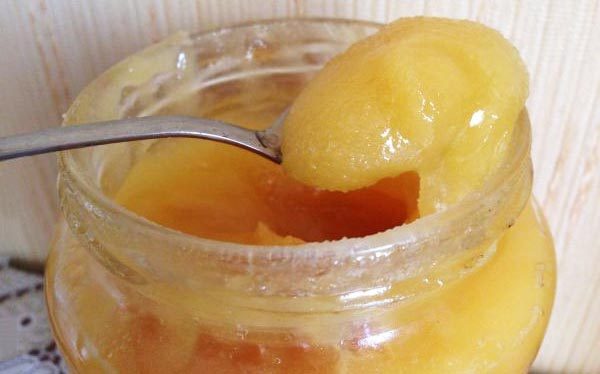
For children, consumption of honey is recommended along with other food — tea, fruit, or cereal. In this way, the body absorbs the treat faster. Giving kids a large amount of product should not be, otherwise they may appear disgust.
When such acquaintance was already, and there were no allergic reactions, then a child under two years old can be offered 0.5 teaspoons, and over two years not more than 1 teaspoon per day. In children who are prone to allergies, honey is excluded from the diet.
Chemical composition and table of contents of components
The table shows the chemical composition and content of all components of the beekeeping product (vitamins, minerals, calories, proteins, fats and carbohydrates) per 100 grams of product.
| Minerals | ||
| Potassium | 64 | mg |
| Phosphorus | 7,2 | mg |
| Calcium | 5,1 | mg |
| Manganese | 0,36 | mg |
| Copper | 31 | mg |
| Zinc | 0,1 | mg |
| Magnesium | 2,9 | mg |
| Iron | 0,5 | mg |
| Chromium | 5 | mg |
| Boron | 0,7 | mg |
| Fluorine | 8 | mg |
| Vitamins | ||
| Vitamin A | 0,04 | mg |
| Vitamin B2 | 0,04 | mg |
| Vitamin b3 | 0,3 | mg |
| Vitamin B5 | 0,07 | mg |
| Vitamin B5 | 0,8 | mg |
| Vitamin B6 | 0,02 | mg |
| Vitamin B9 | 0,08 | mg |
| Vitamin C | 2 | mg |
| Vitamin E | 4 | mg |
| Vitamin H | 0,15 | mg |
| Vitamin K | 1 | mg |
The chemical composition of centrifugal honey(by J.W. White
| Composition | % | g |
| Water (natural moisture) | 17,20 | 78,0 |
| Sahara:
Levulosis (fruit sugar) Dextrose (grape sugar) Sucrose (table sugar) Maltose and other disaccharides Higher sugars |
38,19
31,28 1,31 7,31 1,50 |
173,2
141,9 5,9 33,2 6,8 |
| Total sugars | 79,59 | 361,0 |
| Acids (glyconic, citric, malic, formic, acetic, butyric, dairy, etc.) | 0,57 | 2,6 |
| Squirrels | 0,26 | 1,2 |
| Ash (potassium, sodium, calcium, magnesium, chlorides, sulfates, phosphates, etc.) | 0,17 | 0,8 |
| Total acid, protein and ash | 1,00 | 4,6 |
| Secondary components (pigments, enzymes, vitamins, alcohols, flavoring and aromatic substances) | 2,21 | 10,0 |
| Total | 100 | 453,6 |
GOST for honey products
GOST R 54644 2011 for bee delicacy of the last development “Natural honey. Technical conditions ”is valid from 01/01/2013, but the majority of organizations, marking the goods, put GOST 19792-2001. There is no error here - GOST 19792-2001 is valid until 01/01/2017.
GOST R 54644-2011 is divided into:
- padevy - collected by insects from deciduous or coniferous plantations;
- floral - collected by insects from flowers, honey plants;
- mixed - natural association of these two types.
According to the method of collection, the product is classified into:
- press - extracted by pressing honeycombs;
- centrifuged - extracted from cells using centrifugation;
- honey in honeycombs - a piece or several pieces of honeycombs, placed in a container and poured with a centrifugal honey delicacy.
Only the above listed types of honey product with such data are allowed for sale:
- must be liquid, fully or partially candied;
- no side aromas, with its own pleasant smells;
- be sweet, without too much flavor.
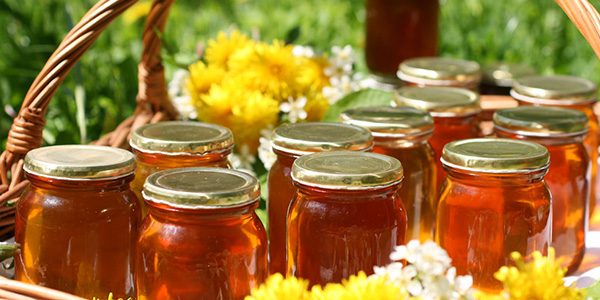
How, where and in what to store the real natural product?
How to store honey at home in an apartment? Store honey in a hermetically sealed container in a dry, well-ventilated place. This is necessary because honey belongs to the category of hygroscopic products. The product absorbs moisture of about 50% of its weight. The room where the honey remains should not have any flavors.
A place in the apartment to preserve honey delicacies should be free of sunlight, well ventilated and cool. A logical question is born: is it possible to put honey in the fridge, because all the criteria match? Yes, you can - this is the right way, especially in summer. In this case, the container should be tightly closed so that the honey does not absorb smells and humidity. It is best to store in a glass container with an airtight lid.
What is the best way to store honey? The most suitable containers for storage are:
- aluminum cans;
- wooden kegs;
- clay and ceramic containers;
- glassware;
- tin containers covered with food-grade paint4
- cardboard cups or paper bags treated with paraffin;
The qualities possessed by honey in honeycombs make it possible to store it in its natural form for a long time. The honey product in this variant is always decontaminated, and the secrets of insect saliva in wax do not allow bacteria to enter the honey. But there is one drawback: the wax permits moisture, which causes fermentation.
How much can you keep real honey at home? Honey delicacy long retains its beneficial properties, while it is a unique product that is stored in its raw form. For example, the famous historian TM. Davis found a container of honey in one of the graves in Egypt, which was 3,300 years old. To his surprise, the honey was in excellent condition.
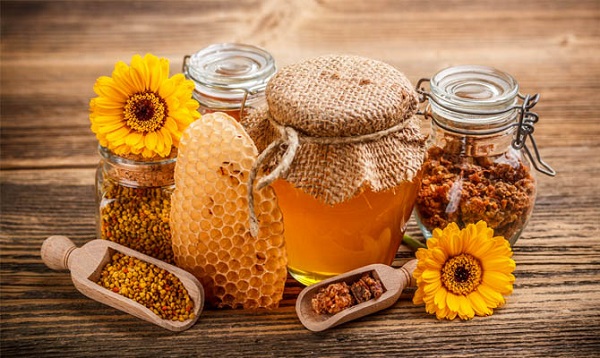
I love honey very much and consider its consumption essential in small doses. Many believe that it can be consumed, for example, one teaspoon per month, because it can exacerbate various diseases.However, if you look at the composition of vitamins and minerals found in honey, you can only be convinced that it brings great benefits! In addition to the consumption of honey directly from the spoon, you can make confectionery or sauces with it.
Sugar - a chemical that is not found in nature in its pure form. To isolate sugar from beets or cane, it is necessary to process raw materials for a long time, affecting it with various harmful substances. There is no question of any vitamins in the resulting product, but an admixture of chemicals may be present in it.
And honey is a completely natural product. The benefits of honey are huge compared to sugar.